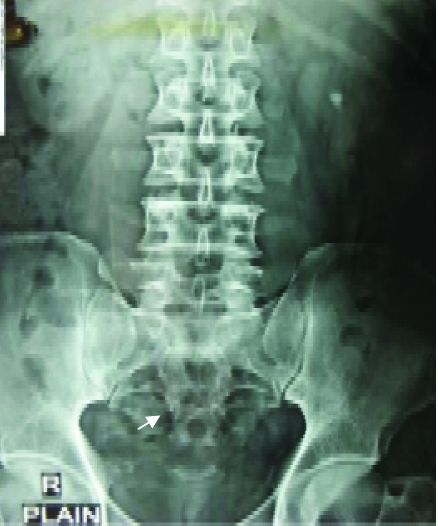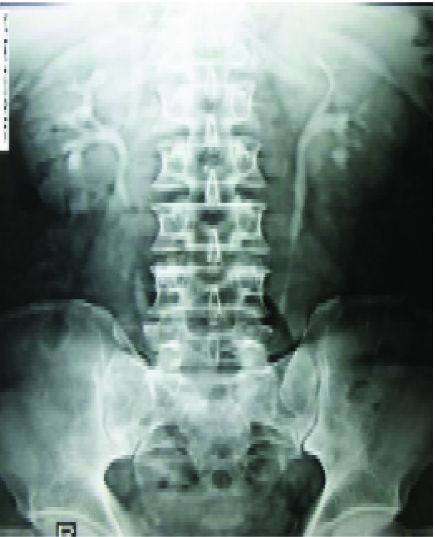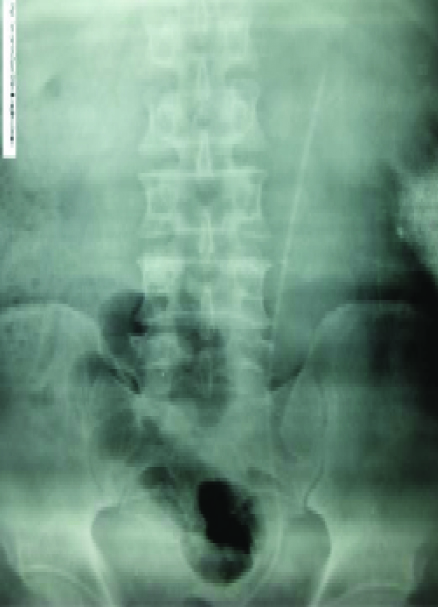Comparative Study of Lithotripsy and PCNL for 11-15 mm Lower Caliceal Calculi In Community Health Hospital
Narendra Haribhau Wankhade1, Jayant Gadekar2, Babaji B. Shinde3, Julie Anand Tatte4
1 Consultant, Department of Urology, Wankhade Kidney Hospital, Opposite Tarakpur S.T. Stand, Ahmednagar, Maharashtra, India.
2 Professor, Department of Surgery, Padam Shri Dr.V.V.P. Medical College, Ahmednagar, Maharashtra, India.
3 Professor, Department of Pathology, P.Dr.V.V.P. Medical College, Ahmednagar, Maharashtra, India
4 Consultant, Department of Anesthesia, Wankhade Kidney Hospital, Opposite Tarakpur S.T. Stand, Ahmednagar, Maharashtra, India.
NAME, ADDRESS, E-MAIL ID OF THE CORRESPONDING AUTHOR: Dr. Narendra Haribhau Wankhade, Wankhade Kidney Hospital, Opposite Tarakpur S.T. Stand, Ahmednagar, Maharashtra, India.
Phone: 91-241-2321601, Cell- 91-9822047115, Fax-91-241-2421290 E-mail ID - nhwankhade@gmail.com
Background and Purpose: Percutaneous Nephrolithotomy (PCNL) is not a popular procedure in smaller sized calculi due to its invasive nature, complications and need for anesthesia. Small sized lower caliceal calculi are generally treated by ESWL but have significantly less clearance rate in spite of several sittings. Here we want to study the efficacy and safe of both procedures in 11 to 15 mm lower caliceal calculi.
Materials and Methods: We present comparative study of lithotripsy and PCNL in 11-15 mm lower caliceal calculi in our hospital. Total 156 patients were studied 78 underwent lithotripsy and 78 underwent PCNL. We compared results in the form of clearance rate, the number of settings needed, hospital stay, need for anesthesia, blood transfusion rate, chest complication, the incidence of sepsis, the need for another procedure, need for stenting in either group.
Results: We found a 67.95% clearance rate in SWL group and 97.43% clearance rate in PCNL group. Hospital stay was minimum in SWL group and was 46 hours in PCNL group. The procedure time was 42 minutes in PCNL and it was 114 mins in SWL (considering all settings). The rest of the complications like chest complication, sepsis and bleeding were negligible due to the small size of calculi.
Conclusion: In a small sized LPC calculi, PCNL is gaining increased popularity due to lower complication and high safety and complete clearance rate. It is wide accepted by society as the patient is totally stone free at the end of the procedure. SWL is less invasive but less effective and has given significant discomfort to patients.
Introduction
Percutaneous Nephrolithotomy (PCNL) is established endoscopic procedure in all types of renal calculi especially stones more than 20mm [1,2]. It is not a popular procedure in smaller sized calculi due to its invasive nature, complications and the need for anesthesia. Small sized lower caliceal calculi are generally treated by Shock wave lithotripsy (SWL) but have significantly less clearance rate in spite of several sittings [3,4]. These patients suffer significant discomfort in spite of the noninvasive nature of SWL [5].
With increasing experience of the surgeon, miniaturization of instruments better imaging, PCNL is becoming, minimal invasive and complication free [3,6]. In smaller sized Lower Pole caliceal (LPC) calculi, PCNL is single step, uniformly effective, safe, widely accepted and uniformly available procedure. We herewith publish patients of 10 to 15 mm renal calculi managed by PCNL and ESWL.
Materials and Methods
In total 156 patients, aged between 15-62 years of either sex was included in the present study. Patients were subdivided into 2 groups, Group I - 78 patients who underwent SWL and Group II - 78 who underwent PCNL. All patients of Group I underwent routine lab tests, Ultrasonography (USG).
Intravenous pyelogram (IVP). Group II underwent routine lab tests USG, IVP, Coagulation profile, Cross match and cardiac profile when needed. Patients with Sr. Creatinine > 2mg % and patients with addition stones in another calyx or pelvis were excluded from the study.
We studied all 11-15 mm lower caliceal calculi managed by SWL and PCNL as a primary treatment modality. The patients were explained in detail about the advantages and disadvantages of the procedures. Patients were randomized into two groups.Group one underwent SWL and group two PCNL. Valid written inform consent were taken. The patients were explained in detail about the advantages and disadvantages of the procedures. The study was conducted between August 2009 and July 2012. SWL was conducted on Dorniel compact alfa. The frequency was used between 60-80 and intensity between 3-4. All procedures were conducted by a single operator on the same machine. The stenting was done whenever necessary and maximum 3- 4 sittings were done. The clearance rate was studied depending upon the presence of more than or equal to 4 mm size calculus on USG or digital radiography after two weeks of last sitting. The patients with residual calculi were followed for pain discomfort related to the procedure. Whenever necessary another procedure like PCNL or RIIS was performed for residual stones.
Patients with microbiological infection were treated before the procedure. In all 78 patients with small sized [11mm -15mm] were treated by PCNL as a primary modality. Patients with multiple LPC calculi included if size fulfills the criteria. Out of 78 patients, 74 were fresh cases 4 were failed lithotripsy cases.
PCNL was performed in all cases under regional anesthesia, fluoroscopy control. Alken dilators were used and 22, 24 and 26Fr Amplaz Sheath were used as necessary. All cases were performed by single endourologist. In all patients Nephrostomy [12 or 14 Fr Nelatone catheter was kept post-operative for 24 hours. DJ stent was kept when necessary. Ureteric catheter was kept when DJ stent was not used. Pneumatic lithoclast was used for fragmentation and Alligator or tripronge forceps were used for retrieval of fragments. Post-operatively analgesics, antibiotics were used as routine. After 24 hours CBC, Sr creat was done. All patients underwent digital X-ray KUB on the second post-operative day. Nobody needed second look Nephroscopy. Patients with no bacteremia on laboratory study and clinically and had no additional symptoms were discharged after 48 hours. USG was performed at 1 month, 3 month and clearance rate decided on the USG findings. Patients were considered to be stone free if there is no stone or less than four mm stone on USG.
Results
This shows significant less clearance rate in SWL (67.94%) [Table-Fig-1]. The need for another procedure add significant economical burden and dissatisfaction. The patients with residual stone experience significant discomfort and dissatisfaction. Another procedure adds a significant economical burden on them [Table-Fig-2].
| S. No. | Title | Result | Range |
|---|
| 1 | Clearance rate | 67.94% | 53/78 |
| 2 | Sittings needed | 3.38 | 1-5 |
| 3 | Intensity needed | 3.25 | 2-4 |
| 4 | Need for another procedure | 15.38% | 12/78 (4 PCNL, 5 URS, 3 RIIS) |
| 5 | Need for stent | 10.25% | 08/78 |
| S. No | Title | Result | Range |
|---|
| 1 | Average stone size | 12.6mm | 10-15 mm |
| 2 | Nature of stone | 74 fresh and 4 failed SWL | 94.87% |
| 3 | Average Sr creatinine | 1.1 mg% | 0.8-2 mg% |
| 4 | Mean operative time | 42 min | (32-87 min) |
| 5 | Blood transfusion | 1.28% | 1 in 28 |
| 6 | Site of puncture | Supracostal 2.57% Infracostal 97. 43% | 2/78 76/78 |
| 7 | Clearance rate | 97.43% | 76/78 |
| 8 | Post-operative stay | 46 hours | 40-56 hours |
| 9 | Bacteremia | 3.85% | 3/78 |
This shows very high clearance rate with PCNL. Mean hospital stay is also very less. Need of blood transfusion is negligible. Most of the punctures are infracostal making the tract safe from chest complications. Nobody suffered major sepsis; death or need for abandoned the procedure. Bacteriemia was easily treatable. USG was performed at 1 month, 3 month and clearance rate decided on the USG findings. Patients were considered to be stone free if there is no stone or less than four mm stone on USG.
X-ray KUB shows left 13mm renal calculus in lower pole calyx [Table/Fig-3]. IVP of the same patient shows left renal calculus with good renal function [Table/Fig-4]. Post-operative X-ray KUB shows no calculus that shows complete clearance by PCNL [Table/Fig-5].
X-ray KUB 13MM lower caliceal calculus

IVP left normal functioning kidney with no hydronephrosis

Post-operative X-ray KUB with complete clearance

Discussion
PCNL is established endourological procedure for renal calculi > 20mm [1]. It was not popular in smaller sized stone due to its invasive nature, complications and need of anesthesia [3]. But after studying results we came to the conclusion that the complication rate increased when the size and number of the stone increases. Complications are negligible when size of stone is smaller and other factors [RFT] are accepted [2,3]. Like chest complications increases when supracostal puncture is selected. Blood transfusion rate, bacteriemia, post op leak and long operative time are only high if stone burden is high [2,3]. Therefore complications encountered during PCNL are not of the procedure itself but are due to stone burden and patient parameters [3]. Lower caliceal calculi are difficult to manage by a single procedure [2]. SWL is a non invasive procedure but clearance rate is significantly low in spite of multiple sittings [5,7]. This gives patients significant discomfort like pain, infection, which leads to absence from the job though does not need hospitalization [5,8]. SWL also requires study of anatomy of lower calyx like, infundipulopelvic angle [1,7,9] diameter and length of lower caliceal infundibulum results and fair if parameters are suitable [4]. The clearance rate is excellent if stone is less than 1 cm [10]. There are no standard parameters to study favorable and unfarourabale anatomy [9]. PCNL does not need favorable anatomy knowledge it is uniformly successful in any type of stone and diversity of stone nature does not hamper clearance rate [2]. We at our institute have seen the patients of LPC calculi suffering significant morbidity and discomfort from ESWL and also unaccepted clearance rate [5,11,12]. RIRS is nowadays getting popularity in the management of the lower caliceal calculi [4]. PCNL is single step, rapid, complication free and widely available procedure. The need for blood transfusion was very less in small sized calculi. Mean operative time is also low due to better instrumentation and imaging and experienced surgeon [13,14].
In lower calicoes calculi most of the patient (>97 %) need infracostal puncture which make our puncture safe from chest complications [1]. Complete clearance rate is very high (97.5%) which obviated need from another procedure and repeated clinic visits therefore it is widely accepted in society in all class of patients [3]. Transient bacteriemia does happen in few patients but is easily manageable and incidence of sepsis is very low. This makes the procedure safer. The post-operative stay is minimized and is well-accepted as patients are stone free at the end of the procedure [3]. Today for small sized lower caliceal calculi we need a procedure which is noninvasive, complication free, does not need anesthesia, safe, and more than that has uniformly high success rate. No procedure fulfills all the criteria but PCNL almost fulfill many criteria when we see the results and complications [2].
Conclusion
PCNL is an established procedure in bigger sized calculi (>20mm). Initially it was not popular in small sized calculi due to its invasive nature and complications. From our study it has shown that in small sized LPC calculi, PCNL has lower complication and high safety and complete clearance rate. It is wide accepted by society as the patient is totally stone free at the end of the procedure. The hospital stay and anesthesia need, does require but it is easily accepted due to higher clearance rate. In near future PCNL can become primary in all small sized LPC calculi especially in developing countries. On the other hand there is a significantly less clearance rate in SWL. Also incidence of another procedure needed is high. The patients with residual stone experience significant discomfort and dissatisfaction. There is an additional economic burden on them as a result multiple visits to the clinic and absent from the job. If another procedure needs that burden increase further.
[1]. Honey John, Treating lower pole renal stones: in defence of shock wave lithotripsyCan Urol Assoc J 2008 2(6):625-27. [Google Scholar]
[2]. Chibber PJ, PCNL for 1-2 cm LPC calculiIndian J urology 2008 24:538-43. [Google Scholar]
[3]. Reem AB, John DD, Percutaneous nephrolithotomy for the treatment of lower pole renal calculiCan Urol Assoc J 2008 2(6):628-30. [Google Scholar]
[4]. Islam A, Ghoneim Alim Predictive factors of lower calyceal stone clearance after ESWL. A focus on the Infundibulo pelvic AnatomyEuro.Urology 2005 48(2):296-302. [Google Scholar]
[5]. Kupeli B, Biri H, Sinik Z, ESWL for lower caliceal calculiEur- Urol 1998 34(3):203-6. [Google Scholar]
[6]. Watterson JD, Soon S, Jana K, Access related complications during percutaneous nephrolithotomy. Urology versus radiology at a single academic institutionJ Urol 2006 176:142-45. [Google Scholar]
[7]. Gupta NP, Singh DV, Hemal AK, Madals Infundibulopelvic anatomy and Clearance of inferior caliceal calculiJ. urology 2000 163(1):24-7. [Google Scholar]
[8]. Cenk Acar, Cag Cal, Impact of residual fragments following endourological treatment of renal stones. Dept of urologyAdvances in Urology 2012 :5pages [Google Scholar]
[9]. Lojanapiwat B, Soonthornpun S, Wudhikarns Lower pole caliceal calculi stone clearance after eswl, the effect of infundioulopelvic angleJ Med Associ Thia 1999 82(9):891-94. [Google Scholar]
[10]. Christion Chaussay, Thorsten Bergsdorf, Extracorporeal shock wave lithotripsy for lower pole calculi smaller than one centimeterIndian J. Urology 2008 24(4):517-20. [Google Scholar]
[11]. Nauri M, Tliguim Predictive factors of successful treatment of lower caliceal calculi with E dap LTO2Extracorporeal lithotripter Prog. Urol 2000 10(4):529-36. [Google Scholar]
[12]. Ahmed RE, Nahas, Handy M, Ibrahim Flexible URS Vs ESWL for LPC calculi 10-20 mmBJU International 2012 110(6):898-902. [Google Scholar]
[13]. Kukreja R, Desai M, Patel S, Bapat S, Desai M, Factors affecting blood loss during percutaneous nephrolithotomy: Prospective studyJ Endourol 2004 18:715-22. [Google Scholar]
[14]. Glenns Gerber, Management of lower caliceal calculiJ Endourology 2003 17(7):501-3. [Google Scholar]